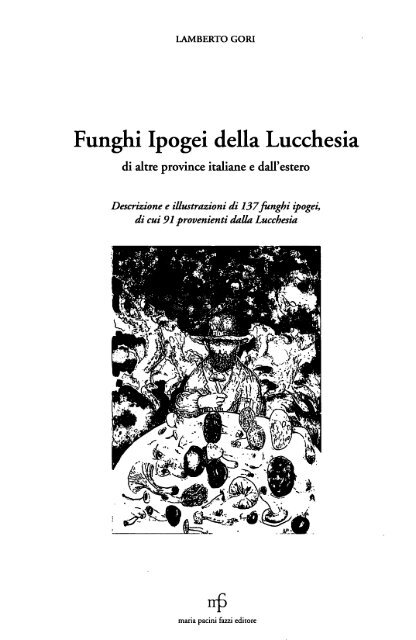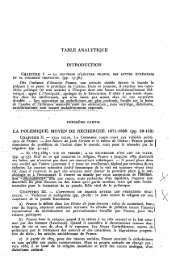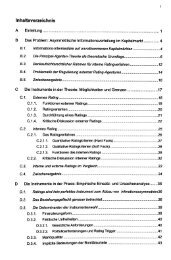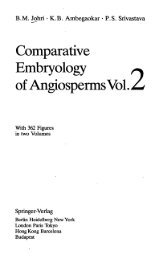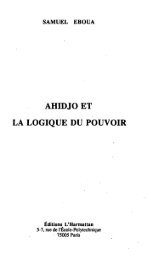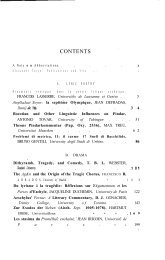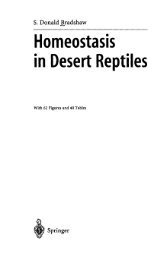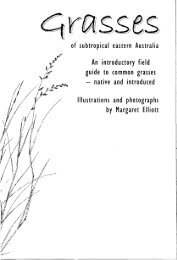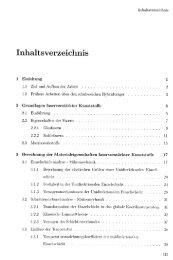You also want an ePaper? Increase the reach of your titles
YUMPU automatically turns print PDFs into web optimized ePapers that Google loves.
LAMBERTO GORI<br />
<strong>Funghi</strong> <strong>Ipogei</strong> <strong>della</strong> <strong>Lucchesia</strong><br />
di altre province italiane e dall'estero<br />
Descrizione e illustrazioni di 137 funghi ipogei,<br />
di cui 91 provenienti dalla <strong>Lucchesia</strong><br />
maria pacini fazzi editore
Autorizzazioni e ringraziamenti pag. 5<br />
Prefazione di Amer Montecchi 9<br />
Prefazione di Mario Sarasini 10<br />
Presentazione di Massimo e Daniele Antonini<br />
Una menzione particolare per Giampaolo Bernardini<br />
11<br />
da Monte S. Quirico (LU) 12<br />
Le motivazioni di questo lavoro di Lamberto Gori 15<br />
Note generali sui funghi e sugli ipogei in particolare 19<br />
Come si trovano i funghi ipogei 21<br />
Inserto 1. Come si trovano i tartufi, alcune curiosità 23<br />
Come si addestra un cane per la ricerca dei funghi ipogei<br />
Cani in azione con i loro addestratori - conduttori<br />
25<br />
proprietari e attrezzi per la raccolta 25<br />
Note storiche 28<br />
Provincia di Lucca<br />
Le piante micorriziche e comari rinvenute<br />
30<br />
con i tuberi in <strong>Lucchesia</strong><br />
- boschi litoranei versiliesi <strong>della</strong> Macchia Lucchese, facente<br />
32<br />
parte del Parco di Migliarino - S. Rossore - Massaciuccoli 32<br />
- essenze <strong>della</strong> Piana Lucchese 33<br />
- boschi collinari attigui alla Piana Versiliese e Lucchese 33<br />
- boschi preappenninici del Tubbiano e delle Pizzorne 33<br />
- boschi appenninici<br />
Note litologiche sommarie <strong>della</strong> <strong>Lucchesia</strong><br />
35<br />
del prof. Umberto Pieruccini 36<br />
Inserto 2. Mostre-mercato tartufi con indotto su altri prodotti<br />
alimentari, sul turismo d'arte, curiosità sociali 37<br />
Tartufaie coltivate 44<br />
Intossicazioni da funghi ipogei e semiipogei v<br />
47<br />
I funghi ipogei commestibili: "i Tartufi in cucina" 47<br />
Le frodi e le sofisticazioni: "i Tartufi in cucina" 50<br />
«Tartufi afrodisiaci ?»<br />
Gli ipogei commestibili <strong>della</strong> <strong>Lucchesia</strong>:<br />
50<br />
i «Tartufi e gli amministratori pubblici» 50<br />
Materiali e Metodi 51<br />
Chiave delle classi dei funghi ipogei / Key to the classes containing<br />
hypogeous fungi 52<br />
ASCOMYCETES Prospetto 52<br />
Ordine: Elaphomycetales 53<br />
Famiglia: Elaphomycetaceae 53<br />
Genere: Elaphomyces 53<br />
Chiave delle principali specie europee 53<br />
Gruppo chiari 53<br />
Gruppo scuri 53<br />
Key to the main european species 54<br />
Light coloured group 54<br />
Dark coloured group 54<br />
- Elaphomyces anthracinus 56<br />
- Elaphomyces asperolus 56<br />
- Elaphomyces cyanosporus 57<br />
- Elaphomyces granulatus 57<br />
- Elaphomyces sp.parassitato da Cordyceps capitata 58<br />
- Elaphomyces maculatus 59<br />
- Elaphomyces morettii 60<br />
- Elaphomyces muricatus 61<br />
- Elaphomyces persoonii 62<br />
Ordine: Peziizales 63<br />
Chiave delle famiglie ipogee o semiipogee / Key to the hypogeous and<br />
semihypogeous families 63<br />
Prospetto: Famiglie ipogee o semiipogee con rispettivi generi 64<br />
Famiglia: Balsamiaceae 64<br />
INDICE GENERALE<br />
Chiave ai generi / Key to the genera 64<br />
Genere: Balsamia 64<br />
Chiave delle specie europee / Key to the european species 64<br />
- Balsamia polysperma 65<br />
- Balsamia vulgaris 65<br />
Genere: Picoa 67<br />
Chiave delle specie europee / Key to the european species 67<br />
- Picoa carthusiana 67<br />
- Picoa juniperi 68<br />
Famiglia: Geneaceae 69<br />
Chiave ai generi / Key to the genera 69<br />
Genere: Genea 69<br />
Chiave delle principali specie europee / Key to the main european<br />
species 69<br />
- Genea fragrans 70<br />
- Genea hispiduta 71<br />
- Genea lespiaultii 72<br />
- Genea sphaerica 73<br />
- Genea verrucosa 73<br />
Famiglia: Helvellaceae (semiipogee) 75<br />
Chiave ai generi / Key to the genera 75<br />
Genere: Choiromyces 75<br />
Chiave delle principali specie europee / Key to the main european<br />
species 75<br />
- Choiromyces meandriformis 75<br />
Genere: Fischerula 76<br />
Specie: Fischerula macrospora 76<br />
Genere: Hydnotrya 77<br />
Chiave delle principali specie europee / Key to the main european<br />
species 77<br />
- Hydnotria michaelis 78<br />
- Hydnotria tulasnei 79<br />
Famiglia: Pezizaceae (semiipogee) 79<br />
Genere: Peziza 79<br />
Specie: Peziza psetidoammophila 79<br />
Famiglia: Pezizaceae 80<br />
Genere: Sarcosphaera 80<br />
Specie: Sarcosphaera coronaria 80<br />
Famiglia: Pyronemataceae 81<br />
Chiave ai generi europei / Key to the european genera 81<br />
Genere: Geopora 82<br />
Specie:<br />
- Geopora arenicola 82<br />
- Geopora cooperi 82<br />
- Geopora sumneriana 83<br />
Genere: Hydnocystis 84<br />
Specie:<br />
- Hydnocystis clausa 84<br />
- Hydnocystis piligera 84<br />
Genere: Labyrinthomyces 85<br />
Specie: Labyrinthomyces donkii 85<br />
Genere: Stephensia 86<br />
Specie: Stephensia bombycina 86
Inserto 3. Struttura del peridio da Balsamia a Stephensia 88<br />
Famiglia: Terfiziaceae 100<br />
Chiave ai generi (compreso Tirmania) / Key to the genera (induding<br />
Tirmania) 100<br />
Genere: Delastria 100<br />
Specie: Delastria rosea 100<br />
Genere: Hydnobolites 101<br />
Specie: Hydnobolites cerebrifbrmis 101<br />
Genere: Pachyphloeus 102<br />
Chiave alle specie europee/Key to the european species 102<br />
- Pachyphloeus citrinus 103<br />
- Pachyphloeus conglomeratus 104<br />
- Pachyphloeus ligericus 105<br />
- Pachyphloeus melonoxanthus 105<br />
- Pachyphloeus prieguensis 106<br />
Inserto 4. Struttura di peridi delle Terfeziaceae da Delastria a<br />
Pachyphloeus 108<br />
Genere: Terfezia 112<br />
Chiave alle specie del Sud Europa e del Nord Africa / Key to the<br />
species of Southern Europe and North Africa 112<br />
- Terfezia arenaria 113<br />
- Terfezia boudieri 113<br />
- Terfizia claveryi : 114<br />
- Terfezia leptoderma 114<br />
- Terfezia olbiensis 116<br />
- Terfizia terfezioides 116<br />
Genere: Tirmania 117<br />
Chiave alle specie / Key to the species 117<br />
- Tirmania nivea 117<br />
- Tirmania pinoyi 118<br />
Inserto 5. Struttura del peridio in Terfizia con aschi (J-)<br />
e in Tirmania con aschi (J+) 119<br />
Famiglia: Tuberaceae 123<br />
Chiave ai generi / Key to the genera 123<br />
Genere: Paradoxa<br />
Specie: Paradoxa monospora 123<br />
Genere: Tuber 124<br />
Chiave delle specie europe 124<br />
Tartufi chiari 124<br />
Tartufi neri 125<br />
Key to the european species 125<br />
Light coloured truffles 125<br />
Black coloured truffles 126<br />
Tartufi neri<br />
- Tuber aestivum 128<br />
- Tuber brumale 129<br />
- Tuber hiemalbum 131<br />
- Tuber indicum 134<br />
Inserto 6. Particolari di alcuni Tuber neri 136<br />
- Tuber macrosporum 140<br />
- Tuber malenconii 140<br />
- Tuber melanosporum 141<br />
- Tuber mesentericum 143<br />
- Tuber regianum 144<br />
Tartufi chiari<br />
- Tuberosa 145<br />
- Tuber bernardinii 146<br />
- Tuber borchii 151<br />
Inserto 6A. Compendio dei Tuber che hanno fino<br />
ad 8 spore per asco 152<br />
- Tuber dryophilum 161<br />
- Tuber excavatum 162<br />
- Tuber foetidum 163<br />
- Tuberftlgens 165<br />
- Tuber gennadii 165<br />
- Tuber gibbosum 167<br />
- Tuber maculatimi 168<br />
- Tuber magnatum 168<br />
- Tuber oligospermum 171<br />
- Tuber panniferum 172<br />
- Tuberpuberulum 172<br />
- Tuber rufum var. rufum 174<br />
Prospetto delle varietà e forme / Scheme of varieties and forms . 176<br />
- Tuber rufum var. apiculatum 177<br />
- Tuber rufum f. ferrugineum 177<br />
- Tuber rufum f. lucidum 177<br />
- Tuber rufum f. nitidum 178<br />
Inserto 7. Quadro riassuntivo dei vari tipi di struttura<br />
del peridio presente nei Tuber chiari con spore<br />
alveolato-reticolate, in rapporto alla larghezza<br />
delle maglie del reticolo 179<br />
BASIDIOMYCETES Prospetto 187<br />
Ordine: Agaricales 187 -<br />
Famiglia: Hydnangiaceae 187<br />
Genere: Hydnangium 187<br />
Chiave delle specie europee / Key to the european species 187<br />
- Hydnangium aurantiacum 188<br />
- Hydnangium carneum 188<br />
Ordine: Agaricales 189<br />
Famiglia: Leucogastraceae 189<br />
Genere: Leucogaster 189<br />
Specie: Leucogaster nudus 189<br />
Ordine: Agaricales 191<br />
Famiglia: Melanogastraceae 191<br />
Genere: Melanogaster 191<br />
Chiave delle specie europee / Key to the european species 191<br />
- Melanogaster ambiguus 192<br />
- Melanogaster broomeanus 192<br />
- Melanogaster variegatus 193<br />
Ordine: Agaricales 194<br />
Famiglia: Secotiaceae 194<br />
Genere: Gyrophragmium 194<br />
Specie: Gyrophragmium dunalii 194<br />
Ordine: Boletales 195<br />
Chiave delle famiglie ipogee / Key to the hypogeous families 195<br />
Famiglia: Chamonixiaceae 195<br />
Genere: Chamonixia 195<br />
Specie: Chamonixia caespitosa 195<br />
Famiglia: Gautieriaceae 196<br />
Genere: Gautieria 196<br />
Chiave delle specie europee / Key to the european species 196<br />
- Gautieria morchelliformis 196<br />
- Gautieria otthii 197<br />
- Gautieria trabutii 198<br />
Famiglia: Rhizopogonaceae 199<br />
Chiave ai generi / Key to the genera 199<br />
Genere: Alpova 199
Chiave delle specie europee / Key to the european species 199<br />
- Alpova diplophloeus 199<br />
- Alpova rubescens 200<br />
Genere: Rhizopogon 201<br />
Chiave delle principali specie europee / Key to the main european<br />
species 201<br />
- Rhizopogon luteolus 203<br />
- Rhizopogon occidentalis 203<br />
- Rhizopogon roseolus 204<br />
- Rhizopogon villosulus 204<br />
- Rhizopogon vulgaris 205<br />
Ordine: Cortinariales<br />
Chiave delle sole famiglie con carpofori ipogei o subagaricoidi / Key to<br />
the only families with hypogeous or subagaricoid fruitbodies .... 206<br />
Famiglia: Cortinariaceae 207<br />
Genere: Setchelliogaster 207<br />
Specie: Setchelliogaster tenuipes 207<br />
Famiglia: Hymenogasteraceae 209<br />
Chiave ai generi / Key to the genera 209<br />
Genere: Chondrogaster 209<br />
Specie: Chondrogasterpachysporus 209<br />
Genere: Gastrosporium 210<br />
Specie: Gastrosporium simplex 210<br />
Genere: Hymenogaster : 211<br />
Chiave delle principali specie europee / Key to the main european<br />
species 211<br />
- Hymenogaster albus 214<br />
- Hymenogaster bulliardii - 215<br />
- Hymenogaster citrinus 215<br />
- Hymenogaster decorus 216<br />
- Hymenogaster griseus 217<br />
- Hymenogaster hessei 217<br />
- Hymenogaster luteus 218<br />
- Hymenogaster lycoperdineus 219<br />
- Hymenogaster muticus 220<br />
- Hymenogaster niveus 220<br />
- Hymenogaster olivaceus 221<br />
- Hymenogasterpopuletorum 222<br />
- Hymenogaster rehsteineri 223<br />
- Hymenogaster thwaitesii 224<br />
-Hymenogaster vulgaris 224<br />
Famiglia: Octavianinaceae 225<br />
Chiave ai generi / Key to the genera 225<br />
Genere: Octavianina 226<br />
Specie: Octavianina asterosperma 226<br />
Genere: Sclerogaster 227<br />
Chiave delle principali specie europee I Key to the main european species 227<br />
- Sclerogaster compactus 228<br />
- Sclerogaster hysterangioides 228<br />
Genere: Wakefielda. 229<br />
Specie: Wakefieldia macrospora 229<br />
Ordine: Lycoperdales 230<br />
Famiglia: Geastraceae 230<br />
Chiave ai generi ipogei o "falsi ipogei" (ricavata da Sunhede) / Key to the<br />
hypogeous or "false hypogeous" genera (taken from Sunhede) 230<br />
Genere: Pyrenogaster 230<br />
Specie: Pyrenogasterpityophilus 230<br />
Genere: Radiigera 231<br />
Specie: Radiigera atrogleba 231<br />
Ordine: Phallales 232<br />
Famiglia : Hysterangiaceae 232<br />
Chiave ai soli generi con carpofori ipogei o semiinterrati / Key to the<br />
only genera with hypogeous or semi-hypogeous fruitbodies 232<br />
Genere: Hysterangium 232<br />
Chiave delle principali specie europee / Key to the main european<br />
species 232<br />
- Hysterangium clathroides 233<br />
Inserto 8. <strong>Funghi</strong> ipogei simbionti degli Eucalyptus sp 234<br />
- Hysterangium inflatum 246<br />
-Hysterangium stoìonifèrum 247<br />
Genere: Phallogaster 247<br />
Specie: Phallogaster saccatus 247<br />
Inserto 9. Struttura del peridio di funghi ipogei<br />
o semiipogei. Basidiomiceti 249<br />
Famiglia: ELismomycetaceae 267<br />
Chiave ai generi / Key to the genera 267<br />
Genere: Gymnomyces 267<br />
Chiave delle principali specie europee / Key to the main european<br />
species 267<br />
Specie: Gymnomyces xanthosporus 268<br />
Genere: Zelleromyces 269<br />
Chiave delle principali specie europee / Key to the main european<br />
species 269<br />
Famiglia: Russulaceae 269<br />
Chiave ai generi subagaricoidi o gasteroidi / Key to the subgasteroid<br />
or gasteroid genera 269<br />
Genere: Arcangeliella 269<br />
Specie: Arcangeliella stephensii 269<br />
Genere : Macowanites 270<br />
Specie: Macowanites candidus 270<br />
Ordine: Sclerodermatales 272<br />
Famiglia: Pisolithaceae. 272<br />
Genere: Pisolithus 272<br />
Specie: Pisolithus arhizus 272<br />
Ordine: Stereales 273<br />
Famiglia: Stephanosporaceae 273<br />
Genere: Stephanospora 273<br />
Specie: Stephanospora caroticolor 273<br />
ZYGOMYCETES<br />
Ordine: Endogonales 275<br />
Famiglia: Endogonaceae 275<br />
Chiave dei generi con sporocarpi di una certa dimensione I Key to the<br />
genera with sporocarps of some dimension 275<br />
Genere: Endogone 275<br />
Specie: Endogoneflammicorona 275<br />
Genere: Gbmus 276<br />
Specie: Glomus melanosporum 276<br />
Grafici <strong>della</strong> Temperatura media, Piovosità media e raccolta di funghi<br />
ipogei negli anni 1992-1993-1994 278<br />
BIBLIOGRAFIA 279<br />
Glossario dei termini scientifici 303<br />
Abbreviazioni di funghi ipogei e semiipogei 309<br />
Abbreviazioni di piante, arbusti ed erbe 311<br />
Sigle delle città italiane 312<br />
Permesso e calendario di raccolta per la Toscana dei funghi ipogei: 313<br />
Ricene al Tartufo (Ristoranti La Mora e Buca di Sant'Antonio) 314


